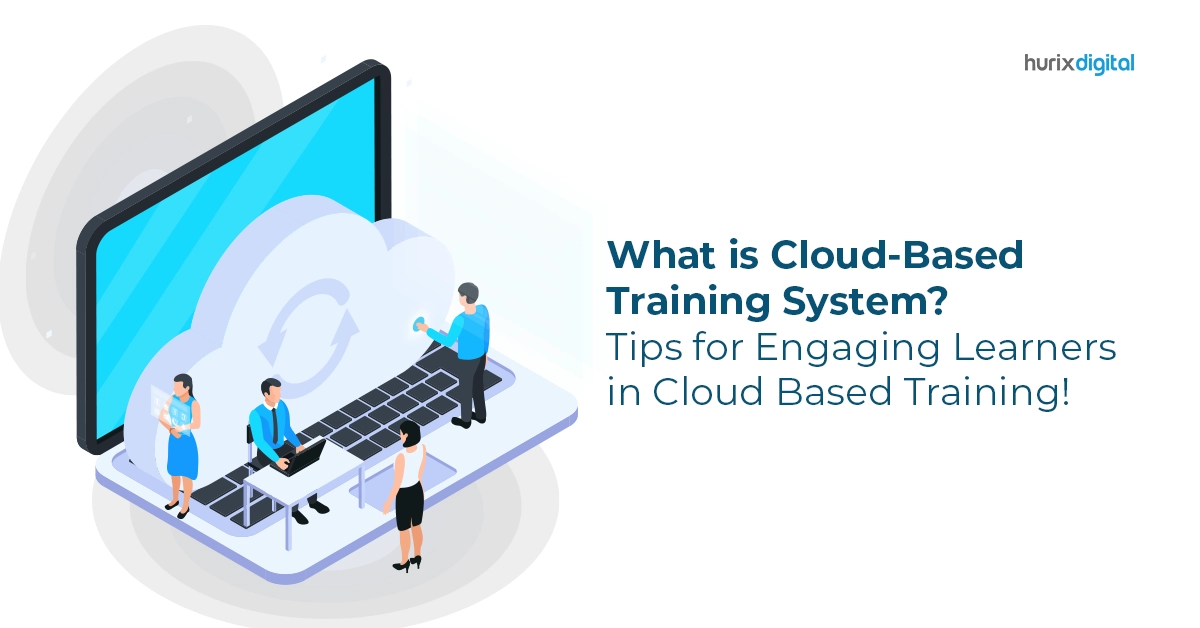
What Is a Cloud-Based Training System? Tips for Engaging Learners in Cloud-Based Training!
Summary
Understand cloud-based training systems and get tips for engaging learners through effective use of cloud technologies in educational settings.
The world of education and training has also seen rapid adoption of cloud technology, mainly due to and after the recent pandemic in the form of cloud-based training systems. As of 2022, cloud-based training was valued at $399.3 billion, and this figure is projected to grow at 14% CAGR from 2023 to 2032.
So, what exactly are cloud-based training systems?
This blog will tell you everything you need to know about them and give you tips on how to engage learners better when using them.
Table of Contents:
- What Is A Cloud-Based Training System?
- The Key Benefits of Cloud-Based Training Systems
- How to Engage Learners and Get the Best Out of Cloud-Based Training?
- Summing It Up
What Is A Cloud-Based Training System?
A cloud-based learning system, more commonly referred to as a Learning Management system, is a Software as a Service(SAAS) technology that can deliver training over the internet.
They differ from traditional or hosted learning management systems requiring specialized software to access learning content. The drawback of these systems is the requirement of being physically present at a location when the said software was installed.
Cloud-based training, on the other hand, offers the flexibility to learn from anywhere as long as one has access to a smart device with an internet connection. This flexibility has made these cloud applications a go-to choice for corporate training programs and education.
The Key Benefits of Cloud-Based Training Systems
Cloud-based training systems have become the norm today, and rightly so due to the benefits they bring to the table.
1. Flexibility and Accessibility
The pièce de résistance of cloud applications is the ability to access its content from form anywhere as long as you have access to the internet. The ability of these systems to be “device-agnostic” enables equal access to learning for all.
Furthermore, cloud training also transcends the limitations of traditional learning in terms of accessibility. Features like text-to-speech, audio and video captioning, and the ability to alter font sizes and colors give anyone access to learning content regardless of their disability.
2. Cost-Effectiveness
Cloud-based training systems are more cost-effective when compared to hosted training systems. With such a system, businesses can save on the capital expenditure of investing in infrastructure and the hardware required to run these systems.
With the need for infrastructure scaled down, you can also downsize the IT and management staff required to oversee and maintain these systems.
3. Technological Superiority
Cloud-based training systems are also technologically superior in many ways. Their features, content, and security can be updated on the fly. This gives you, as a learning provider, the peace of mind of knowing that your learners always have access to the very latest in features and learning content.
These systems are highly scalable, and you only pay for what you use. What’s more, changes in requirements come into effect almost instantaneously. Cloud-based service providers also follow strict cloud monitoring best practices, which results in nearly 100% uptimes.
Finally, the onus of data security falls with the service provider. With the automatic update security updates, you can rest assured that any personal information is as protected as it can be.
Also Read: 5 Secret Ways to Engage Learners in Digital Learning
How to Engage Learners and Get the Best Out of Cloud-Based Training?
While cloud-based training has numerous advantages, you can still follow a few best practices to get the most out of your online training.
1. Design for the Cloud
The first step to take to improve your learner’s cloud training experience is to start with the basics, i.e., designing your content specifically for the cloud.
Unlike hosted systems, cloud-based systems can be accessed from several devices, from workstations to laptops and smartphones. This means any content designed for cloud platforms must feature a responsive design that can adapt to different screen sizes, resolutions, and orientations.
The content must also designed and tested to work across multiple browsers and with low-bandwidth internet connections for a consistent learner experience across the board.
2. Personalize the Learning Experience
The most significant advantage cloud training offers traditional conventional in-person training is the ability to personalize the learner’s experience based on their level of skill and ability.
Cloud-based training systems can do this with artificial intelligence, machine learning algorithms, and data analytics. Together, they can gauge each learner’s progress and performance and alter the difficulty and the pace of learning to ensure they do not feel lost and left out and ultimately lose interest.
3. Make the Content Interactive and Engaging
Modern-day cloud-based training systems come with feature-rich authoring tools that allow you to infuse content with a host of interactive multimedia features.
Images, videos, animations, and infographics are just but a few elements you can add to your training content. Doing so makes for a better learning experience when compared to text-heavy training.
Moreover, multimedia-rich content also ensures that there is content in your training material that appeals to visual, auditory, kinesthetic, and read/write learners. You can also take advantage of gamification, a learning technique with proven benefits in engagement and knowledge retention to keep your learners engaged.
4. Switch Things up Often
Continual impersonal online training can get dreary over time, especially if the learners are geographically dispersed or work asynchronously. Use a combination of learning strategies to keep your trainees engaged in your sessions.
Switch between cloud training, blended learning, and instructed-led training occasionally. You can also break the monotony of training with a quick pop quiz, exciting trivia, or peer-to-peer discussions.
This promotes interaction and collaboration and is a great way to exchange and discover varied opinions or perspectives and learn from individual experiences.
5. Provide Frequent Feedback
Although modern cloud-based training systems have inbuilt feedback mechanisms, regular feedback from instructors can have a much more significant impact on trainees’ view of their training.
While AI is still getting more sophisticated by the minute, it still lacks the human element that can make all the difference. Do not eliminate the human element from the training ecosystem.
Also Read: Best cloud-based learning management system
Summing It Up
Cloud-based training systems are undoubtedly the way forward for training. That said, with all the benefits they bring to the table on their own, it’s still essential to follow a few best practices to get the most out of them.
However, as advanced as they are, they still lack the human element, so it’s best to use them with instructor-led training.
Investing in cloud-based training systems gives your corporate training exercise a significant boost, and if you are looking for a reliable partner to help you create and deliver engaging and effective training programs, look no further than Hurix Digital.
With over 22 years of experience in the industry, we have helped businesses of all sizes overhaul their training programs. Contact us to know more.

Vice President – Digital Content Transformation. He is PMP, CSM, and CPACC certified and has 20+ years of experience in Project Management, Delivery Management, and managing the Offshore Development Centre (ODC).




